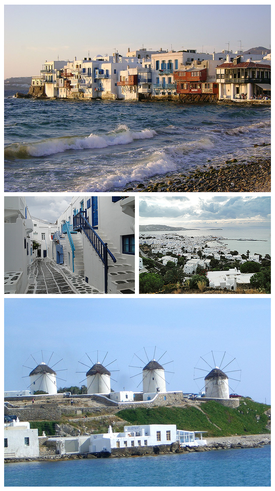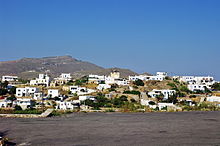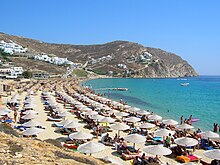Mykonos
Μύκονος Nickname: Νησί των ανέμων (Nisí ton anémon, 'Island of the winds') | |
|---|---|
 Clockwise from top: View of Little Venice in Mykonos, panoramic view of Chora (Mykonos City), the four windmills of Mykonos and the streets of Chora. | |
| Coordinates: 37°27′32″N 25°21′51″E / 37.45889°N 25.36417°E | |
| Country | Greece |
| Administrative region | South Aegean |
| Area | |
| • Municipality | 85.5 km2 (33.0 sq mi) |
| Population (2021)[1] | |
| • Municipality | 10,704 |
| • Density | 130/km2 (320/sq mi) |
| • Community | 8,609 |
| Demonym | Mykonians |
| Time zone | UTC+2 (EET) |
| • Summer (DST) | UTC+3 (EEST) |
| Postal code | 846 00 |
| Area code(s) | 22890 |
| Website | www |
Mykonos (/ˈmɪkənɒs, -noʊs/,[2][3] UK also /ˈmiːk-/;[4] Greek: Μύκονος [ˈmikonos]) is a Greek island, part of the Cyclades, lying between Tinos, Syros, Paros and Naxos. The island has an area of 85.5 square kilometres (33.0 sq mi) and rises to an elevation of 341 metres (1,119 feet) at its highest point. At the 2021 census, there were 10,704 inhabitants, most of whom lived in the largest town, Mykonos, which is on the west coast. The town is also known as Chora (i.e. 'Town' in Greek, following the common practice in Greece when the name of the island itself is the same as the name of the principal town).
Mykonos's nickname is "The Island of the Winds",[5][6] due to the very strong winds that usually blow on the island. Tourism is a major industry and Mykonos is known for its vibrant nightlife.[7][8][9]
Herodotus mentions Carians as the original inhabitants of the island.[10] Ionians from Athens seem to have followed next in the early 11th century BC. There were many people living on the neighboring island of Delos, only 2 km (1.2 miles) away, which meant that Mykonos became an important place for supplies and transit. It was, however, during ancient times a rather poor island with limited agricultural resources. Its inhabitants were polytheists and worshiped many gods.[11]

Mykonos came under the control of the Romans during the reign of the Roman Empire and then became part of the Byzantine Empire until the 12th century. In 1204, with the fall of Constantinople in the Fourth Crusade, Mykonos was occupied by Andrea Ghisi. The island was ravaged by the Catalans at the end of the 13th century and finally given over to direct Venetian rule in 1390.
In 1537, while the Venetians still reigned, Mykonos was attacked by Hayreddin Barbarossa, the admiral of Suleiman the Magnificent and an Ottoman fleet established itself on the island. The Ottomans, under the leadership of Kapudan Pasha, imposed a system of self-governance comprising a governor and an appointed council of syndics. When the castle of Tinos fell to the Ottomans in 1718, the last of the Venetians withdrew from the region.
Up until the end of the 18th century, Mykonos prospered as a trading center, attracting many immigrants from nearby islands, in addition to regular pirate raids. In June 1794 the Battle of Mykonos was fought between British and French ships in the island's main harbor.

The Greek Revolution against the Ottoman Empire broke out in 1821 and Mykonos played an important role, led by the national heroine, Manto Mavrogenous. Mavrogenous, a well-educated aristocrat guided by the ideas of the Enlightenment, sacrificed her family's fortune for the Greek cause. Greece became an independent state in 1830. A statue of her sits in the middle of Manto Mavrogenous square in the main town.
At the end of February 1884, the British travellers Theodore and Mabel Bent visited the island, ostensibly to witness the traditional funeral lamentations (‘mœrologia’).[12]
As a result of sailing and merchant activity, the island's economy quickly picked up but declined again during the late 19th century and especially after the opening of the Corinth Canal in 1904 and the First World War at the beginning of the 20th century. Many Mykonians left the island to find work in mainland Greece and many foreign countries, especially the United States.[13]
Tourism soon came to dominate the local economy, owing a lot to the important excavations carried out by the French School of Archaeology, which began work in Delos in 1873. Mykonos became popular with international "jet set" tourists in the 1960s. In the 70s it was popular spot for Americans to treat as a nude beach, which Americans imagined to be a feature of those natural "far out" Greeks, and then flourished further to become a popular gay tourist destination in the 1980s. By the 2000s, Mykonos had become one of Greece's most expensive islands.
In Greek mythology, Mykonos was named after its first ruler, Mykonos (Μύκονος),[14] the son or grandson of the god Apollo and a local hero. The island is also said to have been the location of the Gigantomachy, the great battle between Zeus and Giants and where Heracles killed the invincible giants having lured them from the protection of Mount Olympus. According to myth, the large rocks all over the island are said to be the petrified corpses of the giants.[15]


The island has an area of 85.5 square kilometres (33.0 sq mi) and rises to an elevation of 341 metres (1,119 feet) at its highest point. It is situated 150 kilometres (93 miles) east of Athens in the Aegean Sea. The island features no rivers, but numerous seasonal streams two of which have been converted into reservoirs.
The island is composed mostly of granite and the terrain is very rocky with many areas eroded by the strong winds. High quality clay and baryte, which is a mineral used as a lubricant in oil drilling, were mined on the eastern side of Mykonos until the late 1900s.
It produces 4,500 cubic metres (160,000 cu ft) of water daily, by reverse osmosis of sea water in order to help meet the needs of its population and visitors.[16]
The island has a population of nearly 12,500, most of whom live in the main town of Chora.[17]
According to the National Observatory of Athens Mykonos has a hot semi-arid climate (Köppen climate classification: BSh) because of the low overall precipitation, although it has lots of Mediterranean climate (Csa) characteristics and it is highly influenced by the Aegean Sea. The rainy season lasts from October until March.[18] Vegetation follows the typical pattern for the region and grows around mid-autumn and ends in the beginning of the summer.[19] [20]The average daily temperature in the winter is around 15 °C (59 °F), while it is around 27.0 °C (80.6 °F) in the summer. The average night temperature is 11 °C (52 °F) in the winter and 24 °C (75 °F) in the summer.
Because of the seasonal cool "meltemi" wind (similar to the other Cyclades islands) and the moderating sea, summer days are relatively cool, dry, sunny and pleasant. The reason for the low overall rainfall is the rain shadow of the Pindus mountain range, which dry out the westerly winds.[21] Winters in general are mild and wet, with many sunny days even in mid-winter. Snow is infrequent and doesn't stay long on the ground when it falls.
| Climate data for Mykonos | |||||||||||||
|---|---|---|---|---|---|---|---|---|---|---|---|---|---|
| Month | Jan | Feb | Mar | Apr | May | Jun | Jul | Aug | Sep | Oct | Nov | Dec | Year |
| Mean daily maximum °C (°F) | 14.3 (57.7) |
14.9 (58.8) |
16.0 (60.8) |
18.8 (65.8) |
22.9 (73.2) |
26.3 (79.3) |
27.5 (81.5) |
27.5 (81.5) |
25.6 (78.1) |
21.9 (71.4) |
19.0 (66.2) |
16.0 (60.8) |
20.9 (69.6) |
| Daily mean °C (°F) | 12.5 (54.5) |
13.1 (55.6) |
14.1 (57.4) |
16.7 (62.1) |
20.5 (68.9) |
24.0 (75.2) |
25.8 (78.4) |
25.9 (78.6) |
23.9 (75.0) |
20.3 (68.5) |
17.4 (63.3) |
14.2 (57.6) |
19.0 (66.3) |
| Mean daily minimum °C (°F) | 10.7 (51.3) |
11.3 (52.3) |
12.1 (53.8) |
14.5 (58.1) |
18.1 (64.6) |
21.7 (71.1) |
24.1 (75.4) |
24.4 (75.9) |
22.2 (72.0) |
18.7 (65.7) |
15.7 (60.3) |
12.4 (54.3) |
17.2 (62.9) |
| Average rainfall mm (inches) | 73.1 (2.88) |
60.6 (2.39) |
32.7 (1.29) |
16.5 (0.65) |
6.4 (0.25) |
4.2 (0.17) |
0.1 (0.00) |
1.6 (0.06) |
12.1 (0.48) |
26.2 (1.03) |
36.2 (1.43) |
57.2 (2.25) |
326.9 (12.88) |
| Source: National Observatory of Athens Monthly Bulletins (Jul 2008-Mar 2023)[22] [23] | |||||||||||||
There are ten villages:

Local specialities:[citation needed]

The municipality of Mykonos (officially: Greek: Δήμος Μυκόνου) is a separate regional unit of the South Aegean region, and the sole municipality in the regional unit.[24] As a part of the 2011 Kallikratis government reform, the regional unit Mykonos was created out of part of the former Cyclades Prefecture. The municipality, unchanged at the Kallikratis reform, also includes the islands Delos, Rineia and several uninhabited islets. The total area of the municipality is 105.183 km2 (40.611 sq mi).[25]
The mayors of Mykonos have been:[26]
| Year | Municipality population |
|---|---|
| 1971 | 3,863 |
| 1981 | 5,530 |
| 1991 | 6,179 |
| 2001 | 9,320 |
| 2011 | 10,134 |
| 2021 | 10,704 |
It being a Greek island, the economy of Mykonos is closely linked with the sea. However, with the rise of tourism, it plays a minor role during summer.[27]





The original Neoclassical building underwent refurbishments and expansions in the 1930s and 1960s and the large eastern room was added in 1972. The museum contains artefacts from the neighbouring island Rhenia, including 9th- to 8th-century BC ceramic pottery from the Cyclades and 7th- to 6th-century BC works from other areas in the Aegean. Its most famous item is the large vase produced in Tinos, showing scenes from the fall of Troy.[35]



There is an abundance of churches because, for many years, the islanders were required to build a church on their land before building a house.

Mykonos Airport is located 4 kilometres (2.5 mi) southeast of the town of Mykonos and it is served by international flights during summer. The flight from Athens to Mykonos takes 25 minutes.[42]
Mykonos is also accessible by boat and ferries. High speed vessels visit daily from the surrounding islands and from Athens.[43]
Taxis, buses or boats are available for transportation. There are three main bus depots in Mykonos. The northern depot is situated behind Remezzo Club above the old Port and provides regular service to Ano Mera, Elia and Kalafatis. A few hundred meters below, at the Old Port, lays another Depot focusing on the northern destinations of Tourlos (New Port) and Agios Stefanos. The southern Bus Depot is at the town "entrance", called Fabrika and it provides regular service to Ornos, Agios Yannis, Plati Gialos, Psarou, Paraga, and Paradise Beach. Small boats travel to and from the many beaches.[44] Tour boats go regularly to the nearby island of Delos.
In 2013 the Mykonos Biennale was inaugurated offering theatrical, cultural, cinematic, artistic, and musical productions.[45]